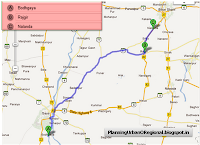It’s
high time they should care for heritage values of shattered settlements.
 |
| Contemporary planning response : A wake-up call!! |
Any Natural calamity, An Earthquake, A Tsunami, A
Flood or A Hurricane strangles the life of community and leaves a physical and
emotional mark behind! Damage which is irreversible, but still people gather
their spirit and strength and try to reconstruct that which has been shattered,
their home, their neighborhood, their community, their village, their city, sometimes
on their own sometimes hand in hand with community, with the support of
government and with the aid and good wishes from around the world. It’s a
collective effort of those who care to rebuild, those who feel responsibility
to reconstruct, everyone contributes their bit!
A relevant question to ask here is that what an urban planner, an architect, an urban designer, a conservationist or a policy
maker can do to restore the faith, hope and dignity of that community, How they
can better contribute in the socio-physical reconstruction after an unforeseen natural
calamity which physically shatters the settlement, a settlement which might
have evolved in course of centuries whether it’s a village or a small town or a
metropolitan city. Of course such situations demand a quick immediate response,
a fast solution, a resettlement plan, a re-construction effort, a physical
master plan to absorb and protect the affected population as quickly as possible;
an infrastructure fast and techno-economically optimized enough to be viable. But
in this race of providing the immediate comfort and amenities to the affected
population we usually tend to forget or sometimes purposefully ignore the very
basic need of community, the settlement itself, the fabric of settlement with
which community has intimately remained attached throughout its life, probably
they have grown together help shaping each other and hence the highly emotional
bonding of community and settlement cannot be ignored neither its legacy of
heritage value and learning.
In a neighborhood or community affected or
devastated by natural calamity, an individual is not just bothered about his or
her own loss, their own damaged house, but they are subconsciously also moved
by the loss of others in the community and their very own settlement and
neighborhood which has been shattered heavily. Their memories of growing in
that neighborhood, those winding streets, their facades and architecture, their
community spaces, those lingering familiarities and so on. We can try to reconstruct
the original face of settlement if the damage is low and concealable, but
sometimes they feel it’s better to reconstruct the settlement in adjacent open
lands if the physical damage is much, this phenomenon is more noticeable and
even more a point of concern in the rural or small urban communities. Usually physical
planning response form the government and planners after a natural calamity in
most of the cases is generally a super-optimized techno-economic solution, an efficient
physical infrastructure, fast paced architecture, but surprisingly lacking in
emotional response and nativeness in terms of architecture, lacking in regional
impression and heritage values of planning, alienated from urban/ rural design principles
and practices of the region, a shear absence of conservationist inputs and
above all lack of human touch. Outcome seems an efficient but emotionless physical
planning response which can and are being radially justified in the name of
constrained resources and urgency of demanded action. Image above speaks for
itself!
Though a much needed temporary relief, imagine the
emotional and functional pain this new mechanical re-settlement master plan causes
to the inhabitants in longer course of time through its totally alienated new
physical planning environment, fabric and architecture, by continually
reminding them of the disaster which occurred in past, due to its ever-present imposed
unfamiliar environment. Imaging the continual struggle to adapt to this new
imposed “efficient but rigid” neighborhood plan which has no relation
whatsoever to the original form and architecture of the village or town which
was devastated in earthquake or else and the loaded feeling of never to return
to a spatial experience in their lifetime which even vaguely resembles to their
original neighborhood or to a locality with its regional character! Imaging the
loss to the future generation who is going to grow up in these reconstructed integrated prefab concrete township or villages with identical kind of off the shelf household
unit next to the fading ruins of their devastated ancestral village and who
will never know how it is like to live in the vibrant settlements were their
parents, their grandparents and their ancestors used to live!
It’s high time that the legacy of heritage planning
values, unique and integral to specific regions need to be acknowledged and
incorporated in the post disaster reconstruction efforts specially in physical
planning of the settlement which will have a long term beneficial effect. Even
the communities in crying need of immediate physical reconstruction support, in
a post-natural-disaster environment, need a physical planning solution with a “human touch”!

















